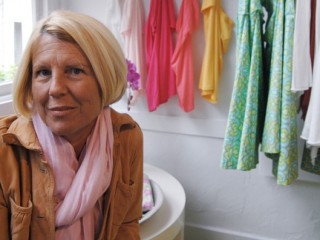
Sigrid Olsen biography
Date of birth : -
Date of death : -
Birthplace : Connecticut, USA
Nationality : American
Category : Famous Figures
Last modified : 2011-09-09
Credited as : fashion designer, ,
1 votes so far
Born in 1953, Olsen grew up in a household devoted to art, not commerce. Her father was a painter, and a grandmother had been involved in the fashion industry. She was drawn to art herself from a very young age, she told Organic Style , noting that "I was an only child and spent a lot of time by myself." Summer vacations were spent on Block Island, located off the coast of Rhode Island, and Martha's Vineyard, a Massachusetts island and popular New England-area resort. She entered Montserrat College of Art near Boston, and married her first husband, whose surname was Olsen, in 1974, the same year she graduated.
Olsen began her career as a weaver, and by 1984 had joined with four other artists to form a co-op crafts gallery they called Ten Hands in Rockport, Massachusetts. Around this same time she began printing her own fabrics, which she did by using potato halves to produce colorful, abstract, patterns. She began selling home wares such as quilts and pillows made from her fabrics, and then ventured into clothing. In the spring of 1986 she launched Segrets Sun Prints, a line of apparel, which she wholesaled to boutiques across New England and as far away as California and Florida.
By 1994, Olsen's company had done a line of golf and tennis wear, but subsisted mainly on sales from sweaters and knits to specialty stores across the United States. That year, she changed the name on the label to her own, and continued to produce sportswear and more workplace-appropriate gear that appealed to her core customer base. A dress line was added in 1995, and by 1998 sales were estimated at $60 million. In early 1999, Liz Claiborne Inc. announced it was adding the Sigrid Olsen label to its growing roster of clothing brands, at a price later revealed to be $54 million. It was a year of impressive acquisitions for the Claiborne group, including Laundry by Shelli Segal and Lucky Brand Dungarees, that made it a leader in the U.S. women's apparel market.
After the deal, Olsen retained a stake in her company just over 15 percent, as well as creative control, but the agreement allowed her brand to tap into its parent company's massive manufacturing, marketing, and distribution resources. It added Sigrid Olsen petite and women's sizes to its divisions, which already included a denim line, and began opening its first retail stores in 2003. The first was located in the Chestnut Hill area of Newton, Massachusetts, an affluent suburb of Boston. "I've beendreaming about retail for a long time," Olsen told a reporter for WWD , Katherine Bowers, on opening day. "And I wanted exactly what we have here, which is a very faithful representation of the brand."
More stores followed later that year, and Olsen returned full circle to her original line of products with a home furnishings launch in early 2005. Her company also wooed a renowned industry executive, Ellis Kreuger from Tocca, to serve as design director when Olsen's executive and retail-appearance obligations began to take up most of her work schedule. The company hoped to hit a goal of 100 stores by 2007, but began to move toward a more distinctive style after Olsen and Claiborne hired Pompeii A.D., a New York City retail design firm responsible for the French-country-charm look of Anthropologie stores. The newer Sigrid Olsen stores had a homier look, with couches and art, as well as photographs of Olsen on vacation and in her home. There were even limited edition prints of hers available for sale. As the designer explained in a July of 2005 interview with Joan Verdon for the Bergen County Record , it was part of a plan to set her stores apart from the competition, which included Chico's, Ann Taylor, and J. Jill. "Right now we're known for my clothing, my apparel, just like Ann Taylor is," she told Verdon. "But there is no Ann Taylor and there is a Sigrid Olsen. And Ann Taylor's not an artist, and Ann Taylor didn't start the company herself."
With plans for eyewear, a swimsuit line, and even footwear, Olsen believed she knew how to deliver appealing goods to her target customer, the baby boomer. She said she felt a kinship with her customers, and had little trouble coming up with fresh takes on her signature look. "My whole lifestyle and attitude is very active, very modern," she told Verdon in the Record . "But I think that is more and more the norm for people in my generation. Today's 50-year-old isn't your mother's 50-year-old."
Olsen's daughter, Brita, is an executive at the company, which still keeps an office in Wakefield, Massachusetts. Olsen lives near there, in the town of Hamilton, but has an apartment in New York City close to her Seventh Avenue showroom. "I need distance from the craziness of New York to work in the art studio in my house," she explained to WWD 's Rosemary Feitelberg. "That's really the nucleus of the creative part of me." Coming from a family so devoted to artistic pursuits, she admitted that even as her business thrived, relatives "were all skeptical," she told Organic Style . "My dad asked, 'When are you going to get back to your art?'"
















